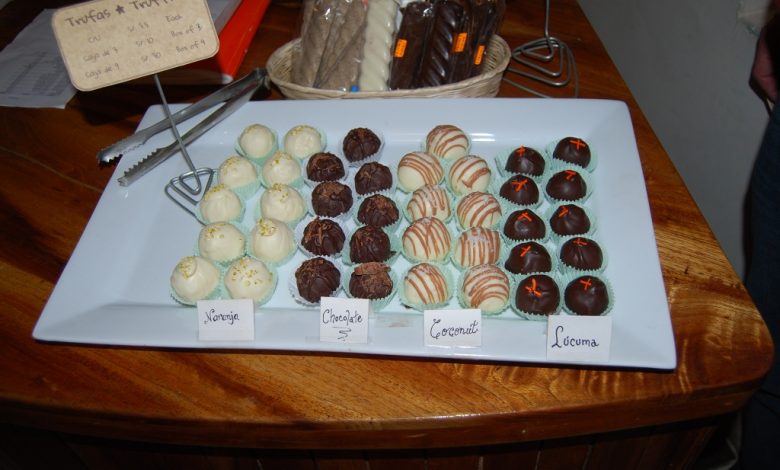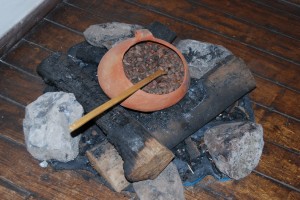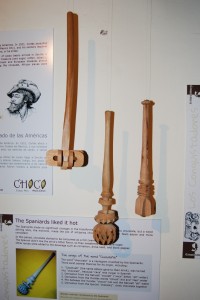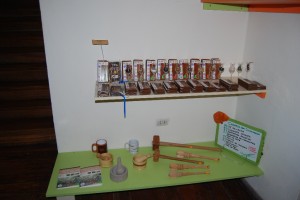A Story of Chocolate in Cuzco

Chocolate and love fall together so frequently that as a couple they are a cliché. Yet in Cuzco a new cafe and museum bring them together in a story that is not only about good food, information, and helping people, it is a love story with twist, turns, and lots of chocolate.
Overlooking the well-named Plaza of Joy, the Plaza de Regocijo or Kusipata as it is now officially called in Quechua, is the two story Choco Museo. It is fitting it is here, in the upper part of a colonial building since in Inca times Cuzco had two plazas divided by the Huatanay River which both had great ceremonial and cosmological resonance.
The largest plaza, today the Plaza de Armas, was the Haucaypata or Wacaypata, depending on who states it, the plaza of pomp and gravitas, or the plaza of sorrows. The smaller plaza was the Kusipata. Just like in a good love story seriousness and gravity, as well as a dash of sorrow, go together with joy.
On the Plaza of joy today, the Choco Museo is crowded with people from many countries, reading the story of chocolate from ancient times to today and looking at pictures and artifacts. Then there is a group learning how to process cocoa beans to get the delicacy that so often becomes a gift of love. There is also a café and store where people can try hot chocolate, drink cacao tea, something rare and unusual in much of the world, or try dipping fruit in chocolate fondue. To take away, they can buy the requisite t-shirts as well as chocolate spinners, or they can pick up hand made chocolate bars or fresh truffles.
Though only open for four months, the Choco Museum is quickly becoming an important stop on the tourist trail through Cuzco. To understand why this is, we must get to our story.


Alain Schneider, a tall, thin Alsatian with a smile that can even warm Cuzco’s ancient stones tells how as a recent university graduate in engineering he was living in an expensive apartment in the heart of Paris and enjoying a good life, with lots of visits to Parisian restaurants. He had taken his studies at the prestigious Ecole Centrale de Lille, which emphasizes engineering, in its major on society and enterprise, a kind of training in engineering and entrepreneurship.
While at the Ecole, he had met Clara Isabel Dias, a fellow student, and felt a certain resonance. They began seeing each other and working together.
Alain not only trained as an engineer but, giving free rein to his artistic side, had also trained outside the university as a mime and clown. And, indeed, even without white-face, he has the classic look of a mime, including a sense of hardship behind his easy smile.
As a result of his dual training Alain had a business in Paris providing entertainment for events, but — there always must be difficulty in any love story – then the global financial crisis hit. Businesses pulled back and quit sponsoring events and his contracts began drying up.
Alain and Clara Isabel looked at each other as they watched their hopes diminish. “We have some money in the bank. How about we go somewhere and volunteer for a while. Maybe we can even find some work and not allow our savings to fade.”

Thinking that opportunity often comes from traveling to a different place and different reality, Alain and Clara Isabel boarded a plane to Central America.
While volunteering, they also began to use their knowledge to offer to oversee music for parties. At one such party they met an American entrepreneur, let’s just call him Mitch, who was opening a hotel in Granada, Nicaragua. After speaking with Alain and learning his talents, Mitch asked him to help in setting up the hotel. Alain and Clara Isabel agreed to stay for six months. But after those lapsed Mitch asked if they would stay for six more.
Along the way Alain, who seems like he often lays awake nights thinking up new ideas, was looking for something to do that was not being done.
He saw the importance of cacao in Central America and people’s love of chocolate, but realized few people knew how one got from the fruity pods of the cacao plants to those amazing bars of dark delight. So he and Clara Isabel began looking for information, at first on line, and then travelling to cacao plantations and factories.
They suggested to Mitch they open a museum of chocolate in the new hotel. And, it became a success. Not only was it a museum with displays and knowledge, it also provided a hands on experience of learning to make chocolate from scratch as well as tours and a small store of goods related to chocolate.

But Alain was restless. His ChocoMuseo, as he called it, belonged to Mitch his financier and Alain longed to strike out for new territories and new ideas. So he and Clara Isabel hopped a plane again, this time for Cuzco, Peru where not only do you have a large tourist presence, you also have an important cacao growing region nearby.
Four months ago they opened the ChocoMuseo in Cuzco and began promoting it. But since his model was not just that of a static museum, Alaina and Clara Isabel needed raw material. They needed cacao.
Alain travelled the very difficult road that drops from snowy heights above Cuzco down into the jungle past Machu Picchu. He went to the region called La Convención, well known for coffee sugar cane, and cacao. A major cooperative COCLA dominates production and distribution of cacao and coffee, though small holders do the actual growing.
The fermentation of the cacao in La Convención did not satisfy Alain. It just wasn’t reaching the level of quality he wanted. So he found a small group of farmers who had broken with COCLA and formed a new cooperative called José Olaya. They were willing to improve their processing of cacao beans.
Alain works with a small set of farmers and agreed with them to pay them 40% more than the going rate for cacao if they would improve the fermentation.
He also wanted to work solely with beans from the native Chuncho variety because of its superior flavor and percentage of cocoa butter. But this variety produces much less than the more commercial varieties. Alain, as a result, is working with the farmers to improve watering and fertilizing to radically improve the production of the trees while keeping quality.
In his museum in Cuzco, Alain and his staff make chocolate bars from this cacao and, with the help of chocolatier Neely Cohen from New York, began making local truffles with specifically local fillings from chirimoya and lúcuma, as well as coca and maras salt.
Neely and her helpers also teach people how to make chocolate and help them make their own chocolate products. The ChocoMuseo also offers tours to the plantations of COCLA in La Convención since they are more set up to receive tourists than is José Olaya.
But more than anything else, the ChocoMuseom is a place to sit an relax from the tourist fray while sipping a fragrant hot chocolate or while dipping fruit into chocolate fondue. The piece de resistance, however, is a subtle tea made from chocolate shells. Its flavor is an ongoing temptation and the tea has become very popular.
At the moment, Clara Isabel is in Nicaragua while Alain is in Cuzco, both overseeing their ChocoMuseos. But Alain is restless.
He will soon open a culinary class in the evenings since the museum closes as dusk comes. With a local chef people will be able to go to the market and buy raw materials while discussing the virtues of different ingredients. Then they will return to this place over the Plaza of Joy and cook.

As if that weren’t enough, Alain has many more ideas. But his museum is often full and keeps him very busy. The delicate and enticing odor of chocolate, a perfume that won’t quit, sits over the place, and Alain can’t wait for Clara Isabel to return from Nicaragua.
ChocoMuseo
Calle Garcilaso #210





Excellent article and easy to understand explanation. How do I go about getting permission to post part of the article in my upcoming news letter? Giving proper credit to you the author and link to the site would not be a problem.
Thank you. You are welcome to use a reasonably sized part of the article as long as you cite and link to the whole article.
Cheers
David